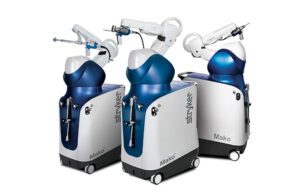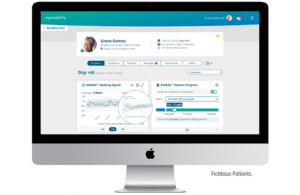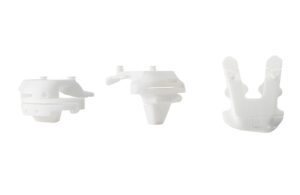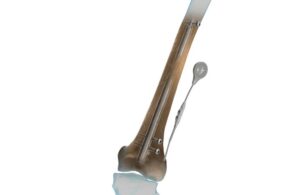 Stryker’s next-gen Mako total robotic knee surgery system and more AI integration for Zimmer Biomet’s ZBEdge surgical platform topped the news at this year’s AAOS 2023.
Stryker’s next-gen Mako total robotic knee surgery system and more AI integration for Zimmer Biomet’s ZBEdge surgical platform topped the news at this year’s AAOS 2023.
The American Academy of Orthopaedic Surgeons 2023 annual meeting drew top medical and medtech talent to Las Vegas from March 7–11.
Here is a roundup of major news coming out of the show:
Stryker launches Mako Total Knee 2.0 surgical robotics platform

Stryker unveiled Mako Total Knee 2.0 at AAOS 2023. Informed by more than 500,000 procedures, Stryker said it designed the next-gen version of the robotic knee surgery system to provide an elevated user experience with customizable workflows and other key features. New features include a digital tensioner for assessing knee stability intraoperatively during total knee arthroplasty — without the need for additional instrumentation.
Stryker began a limited release of Mako Total Knee 2.0 in August 2022. It plans to continue a phased rollout in 2023, starting with the U.S. before launching globally in select markets.
“Over the last six years, we’ve gathered key feedback from our customers and incorporated those findings into the development of Mako Total Knee 2.0 — reflecting our ongoing commitment to our customers and their patients,” said Don Payerle, president of Stryker’s joint replacement division.
Zimmer Biomet announces enhancements to its ZBEdge platform

Zimmer Biomet announced at AAOS 2023 that it plans more AI integration and other enhancements to its ZBEdge Dynamic Intelligence platform for hip and knee surgeries.
The improvements include greater integration of ZB’s WalkAI — artificial intelligence that can predict which patients will have lower gait speed 90 days after hip or knee surgery.
Warsaw, Indiana–based Zimmer Biomet designed its ZBEdge Dynamic Intelligence platform to integrate its digital, robotic and implant technologies. It connects and collects objective data throughout the entire episode of care. The company aims for ZBEdge Dynamic Intelligence to transform data into insights. The goal is to elevate the standard of care.
“Nearly two years following its introduction, ZBEdge Dynamic Intelligence continues to deliver innovations with breakthrough technologies designed to enable smarter decision-making, more efficient care and optimized user experiences,” said Ivan Tornos, COO at Zimmer Biomet.
Smith+Nephew data backs its patient-specific knee surgery tools

During AAOS 2023, Smith+Nephew published a systemic literature review that backs its Visionaire patient-specific instrumentation for knee surgeries.
The research was published online by the Archives of Orthopaedic and Trauma Surgery. It included a meta-analysis of 25 relevant studies that compared Visionaire-enabled total knee arthroplasty (TKA) with conventional instrumentation-enabled TKA.
The analysis demonstrated improvements in alignment accuracy, efficiency in surgical procedures, and reduction in length of hospital stay in comparison with conventional instrumentation, London-based Smith+Nephew said in a news release posted March 6.
People are enthusiastic about getting joint replacements on an outpatient basis
Most people who underwent a total joint arthroplasty on an outpatient basis at an academic medical center (AMC) would do it again.
That’s according to research presented at AAOS 2023. The study backs up the trend of more orthopedic surgeries that don’t require hospital stays.
Lead author Soham Ghoshal, a medical student at Harvard Medical School in Boston, said in a news release that academic medical centers historically haven’t done the procedures on a same-day basis. Showing that people want the procedures on an outpatient basis — and that they’re safe with similar outcomes — could guide the academic medical centers to make a shift, Goshal said.
The study included a total of 281 total joint arthroplasty (hip or knee) and unicondylar knee arthroplasty procedures performed on an outpatient basis at AMCs. Cumulatively, 94.6% of patients said they would undergo their procedure again, and 92.7% would choose a same-day discharge again. The mean time to discharge was 5.4 hours. Only nine patients needed readmission.
Orthofix hits 5,000 mark for Fitbone implantations

During the AAOS 2023 week, Orthofix announced that it has surpassed 5,000 device implants for its Fitbone TAA intramedullary limb-lengthening system.
With more than 20 years of clinical history, the device demonstrated safety and effectiveness in limb lengthening and deformity correction in adults and children, according to Orthofix. It acquired the Fitbone intramedullary lengthening nail from Wittenstein SE in March 2020.
The fully implantable system corrects leg length and deformity discrepancies through a minimally invasive implantation procedure. Fitbone features a motorized intramedullary nail, a subcutaneously placed receiver and an external control set. This enables the patient to manage the distraction phase at home. Once the patient completes their treatment, they have the nail and receiver removed.
Younger total hip arthroplasty patients have low revision rates at eight years
Surgeons are providing more total hip arthroplasty (THA) procedures for people under 65. The concern has been that the younger patients historically had poor long-term outcomes associated with implant failure.
However, a recent study presented at AAOS 2023 drew on American Joint Replacement Registry data to show that only 1% of sampled patients needed revision surgery for THA within an eight-year period. The study also found higher THA revision rates among Black patients when compared to white patients.
“The demand for total hip replacements is expected to increase 174% from 2005 to 2030, and 28% of the 572,000 THA procedures performed annually are in patients under the age of 55,” said lead author David Cieremans, a medical student at Philadelphia College of Osteopathic Medicine.
“When a young and active patient is exploring THA, it’s important for their surgeon to understand the expected life span of the implant to help make informed decisions. The AJRR provided an incredible resource for our team to obtain robust data on hip replacements, along with a standardized metric to analyze surgical trends and patient outcomes from around the country,” Cieremans said in a news release.
Associate Editor Sean Whooley contributed to this report.